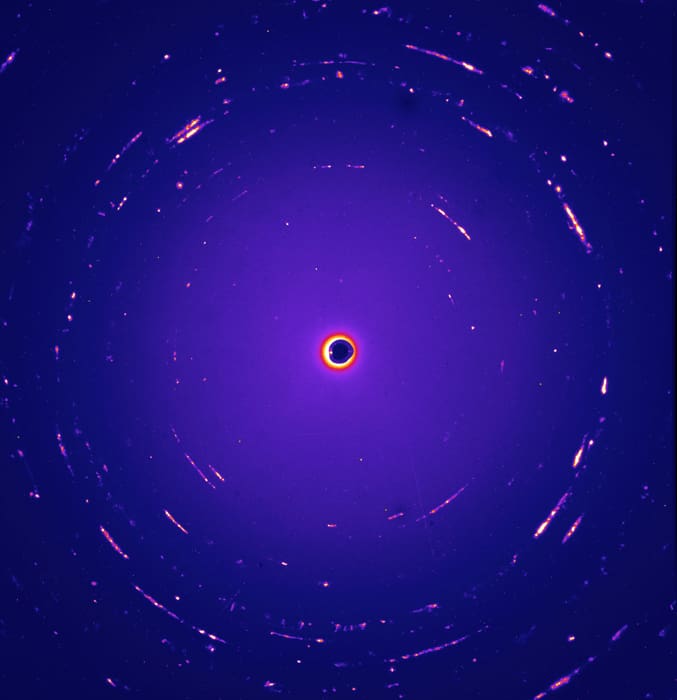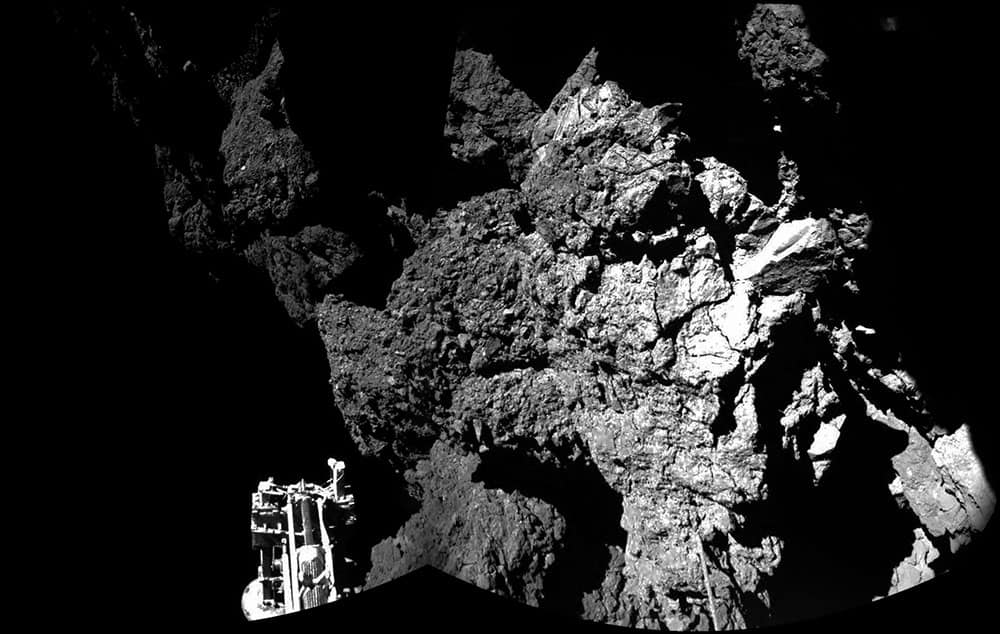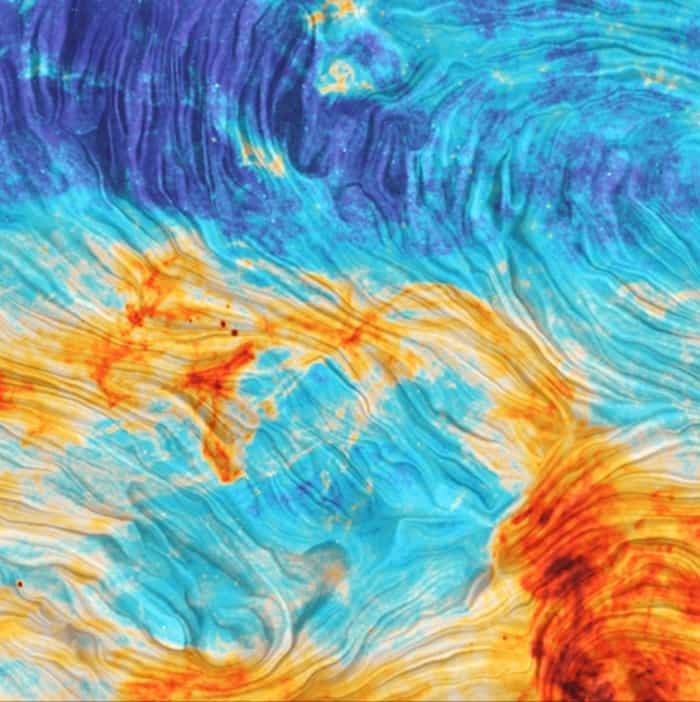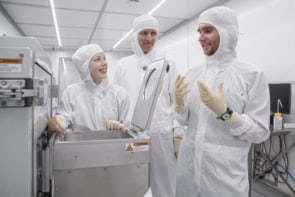Pictures have a way of making the most complex science seem simpler, and here at Physics World we come across some very fascinating images each year. Below are 10 of our favourite images from this year, in no particular order. From a very special grain of dust to a giant ring of dust 240 light-years from Earth to the dust that cloaks our galaxy, the images below depict some of the most exciting physics done this year and we hope you enjoy them

Physics World brings Feynman lecture to life
Commissioned for our March 2014 education special issue, which focused on novel ways to teach and learn physics, the riot of colour above is based on a lecture by Richard Feynman called “The Great Conservation Principles”. It is one of seven Messenger Lectures that Feynman gave at Cornell University in the US half a century ago. This lovely image was created by professional “science doodler” Perrin Ireland – a science-communications specialist at the Natural Resources Defense Council in the US – who describes herself as “a learner who needs to visualize concepts in order to understand them”.
Scientists crack oyster’s secret of strength
The pink and green hues in this colourized, scanning electron micrograph show localized damage on the shell of a windowpane oyster (Placuna placenta). The image was taken by researchers at the Massachusetts Institute of Technology, who uncovered a series of nanoscale mechanisms that make such transparent oyster shells resistant to the piercing teeth of predators. Living in waters off the Philippines and other parts of the tropical central Indo-Pacific region, the windowpane oyster’s shell might be the toughest see-through material in nature, with studies revealing that the shell’s toughness is down to how its very thin calcite layers respond to being hit.
Rise of the real transformers
While the latest Transformers film hit cinemas in the UK in August this year, scientists at Harvard University and the Massachusetts Institute of Technology in the US were busy developing the first “real life” transformer, pictured above. Starting out flat, the robot folds and assembles itself into a complex shape and can then scuttle away – all without any human intervention. These printed robots can self-fold in about four minutes – a huge improvement on previous models that could take up to two hours to do the same thing – and can even turn around, making them a handy tool.
NASA’s Stardust mission snares first dust from beyond the solar system
Seven rare, microscopic dust particles, which could be of interstellar origin, have been found among samples collected by NASA’s Stardust mission. Above is a false-colour image of a diffraction pattern from one of the dust grains, dubbed Orion. The tiny particles show features that are consistent with dust that would be found in an interstellar dust stream, suggesting that they date back to the beginnings of the solar system. If confirmed to be of interstellar origin, the discovery could improve our understanding of the origin and evolution of the solar system itself.
“Angry alien spider” emerges from packing calculations
Determining the most efficient way to pack simple objects such as spheres has entertained and infuriated mathematicians from Aristotle to the present day. Earlier this year, researchers at the University of Michigan in the US took a new computational approach to the problem, by studying how packing efficiency varies as the shape of an object is modified. They looked at how the maximum packing efficiency of tetrahedrons and several other simple polyhedrons varies according to two parameters. So, the alien spider that seems to be guarding its colourful bounty of eggs in the image above is nothing to worry about. In fact, it illustrates a plot of maximum packing efficiency as a function of the two parameters for one selected family of polyhedrons with tetrahedral symmetry. The polyhedrons are shown below the main image, while the corresponding maximum packing density surface is shown in a 3D plot.
SPHERE opens its “all-seeing” eye
While the fiery shades of the image above may seem familiar to fans of the Lord of the Rings movie franchise, pictured above in exquisite clarity is a ring of dust that surrounds the nearby star HR 4796A. This particularly clear image has been obtained by the new Spectro-Polarimetric High-contrast Exoplanet REsearch instrument (SPHERE), which was installed in May this year on the European Southern Observatory’s Very Large Telescope (VLT) at the Paranal Observatory in Chile. Thanks to SPHERE, not only is the dust ring clearly outlined, but the glare of the bright star at the centre of the picture has been supressed. This has provided a much clearer view of the whole system, which researchers think also harbours an exoplanet or two.
Lasers ignite “supernovae” in the lab
Attempting to recreate one of the most massive explosions in the universe in your lab may not sound like such a good idea. But that is exactly what researchers at the University of Oxford in the UK wanted to do, as they used one of the world’s most powerful laser facilities to create tiny versions of supernova explosions in the laboratory. The simulated “bang” was created by firing three laser beams onto a tiny carbon rod in an argon-filled chamber. The exploding rod creates an asymmetric shock wave that expands outwards through the argon gas, much like a real supernova in space. In the image above, the shock and the turbulent flow are captured with the Schlieren imaging technique (blue-black hues). The electron density predicted by computer simulations (blue-red hues) is superimposed.
First view from the comet crasher
Earlier this month, scientists working on the Rosetta mission of the European Space Agency (ESA) made history when their “Philae” module touched down safely on the surface of comet 67P/Churyumov–Gerasimenko. The lander bounced twice, moving nearly 1 km back out into space, and touched the comet’s surface three times before settling at a location nearly 1 km away from the target site. Above is the first panoramic image from the surface of the comet captured by the CIVA-P imaging system, and features a 360° view around the point of final touchdown. One of the lander’s three feet can be seen in the foreground.
Planck offers sharpest view of the early universe
The beautiful image above, which is reminiscent of an Impressionist painting, comes from the latest data from the €700m Planck mission of the European Space Agency (ESA), which was released last month. It shows the 353 GHz polarization sky map as seen by Planck, with the colours depicting galactic dust, while the relief shows magnetic fields. These results cover four years of observations and provide the most precise confirmation so far of the Standard Model of cosmology, as well as placing new constraints on the properties of potential dark-matter candidates. The collaboration also revealed that it has detected traces left behind by primordial neutrinos – thought to have been released one second after the Big Bang – on the cosmic microwave background for the first time.
Hawking in the movies
Early next month, director James Marsh’s biopic based on Stephen Hawking will hit cinemas across the UK. Above is a still from the film, The Theory of Everything. The story is based on the memoir Travelling to Infinity: My Life with Stephen, penned by Hawking’s former wife Jane Hawking, and covers the early days of the couple’s courtship up to the point where the two divorced in 1995. Hawking is played by British actor Eddie Redmayne, who has already received praise for his performance as he portrays Hawking slowly deteriorating because of motor-neuron disease – amyotrophic lateral sclerosis – that he is diagnosed with at an early age.












